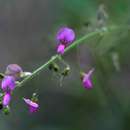Derivation of specific name
provided by Flora of Zimbabwe
tortuosum: much twisted, referring to the pods
- license
- cc-by-nc
- copyright
- Mark Hyde, Bart Wursten and Petra Ballings
- bibliographic citation
- Hyde, M.A., Wursten, B.T. and Ballings, P. (2002-2014). Desmodium tortuosum (Sw.) DC. Flora of Zimbabwe website. Accessed 28 August 2014 at http://www.zimbabweflora.co.zw/speciesdata/species.php?species_id=130890
- author
- Mark Hyde
- author
- Bart Wursten
- author
- Petra Ballings
Description
provided by Flora of Zimbabwe
Erect perennial herb or subshrub, up to 1.5 m. A native of tropical America, it is widespread in the tropical world, where it is cultivated as a nitrogen-enricher. Leaves 3-foliolate with small hairs on both surfaces and longer hairs on the veins below. Inflorescences terminal and axillary, up to 30 cm long. Flowers blue-mauve or pink, occasionally blue-green. Pods up to 3.2 cm, glandular hairy, often twisted at the constrictions between the articles.
- license
- cc-by-nc
- copyright
- Mark Hyde, Bart Wursten and Petra Ballings
- bibliographic citation
- Hyde, M.A., Wursten, B.T. and Ballings, P. (2002-2014). Desmodium tortuosum (Sw.) DC. Flora of Zimbabwe website. Accessed 28 August 2014 at http://www.zimbabweflora.co.zw/speciesdata/species.php?species_id=130890
- author
- Mark Hyde
- author
- Bart Wursten
- author
- Petra Ballings
Frequency
provided by Flora of Zimbabwe
Frequent
- license
- cc-by-nc
- copyright
- Mark Hyde, Bart Wursten and Petra Ballings
- bibliographic citation
- Hyde, M.A., Wursten, B.T. and Ballings, P. (2002-2014). Desmodium tortuosum (Sw.) DC. Flora of Zimbabwe website. Accessed 28 August 2014 at http://www.zimbabweflora.co.zw/speciesdata/species.php?species_id=130890
- author
- Mark Hyde
- author
- Bart Wursten
- author
- Petra Ballings
Worldwide distribution
provided by Flora of Zimbabwe
Native of tropical America but widely cultivated as a nitrogen-enricher and hence naturalised.
- license
- cc-by-nc
- copyright
- Mark Hyde, Bart Wursten and Petra Ballings
- bibliographic citation
- Hyde, M.A., Wursten, B.T. and Ballings, P. (2002-2014). Desmodium tortuosum (Sw.) DC. Flora of Zimbabwe website. Accessed 28 August 2014 at http://www.zimbabweflora.co.zw/speciesdata/species.php?species_id=130890
- author
- Mark Hyde
- author
- Bart Wursten
- author
- Petra Ballings
Physical Description
provided by USDA PLANTS text
Annual, Herbs, Stems woody below, or from woody crown or caudex, Taproot present, Nodules present, Stems erect or ascending, Stems less than 1 m tall, Stems 1-2 m tall, Stems solid, Stems or young twigs sparsely to densely hairy, Stems hairs pilose or spreading, Stems with hooked uncinate hairs or prickles, Leaves alternate, Leaves petiolate, Stipules conspicuous, Stipules green, triangulate to lanceolate or foliaceous, Stipules persistent, Stipules deciduous, Stipules free, Stipules clasping stem at the base, Leaves compound, Leaves pinnately 3-f oliolate, Leaves odd pinnate, Leaf or leaflet margins entire, Leaflets opposite, Stipels present at base of leaflets, Leaflets 3, Leaves hairy on one or both surfaces, Inflorescences racemes, Inflorescence panicles, Inflorescence terminal, Bracts very small, absent or caducous, Bracteoles present, Flowers zygomorphic, Calyx 2-lipped or 2-lobed, Calyx hairy, Petals separate, Corolla papilionaceous, Petals clawed, Petals blue, lavander to purple, or violet, Banner petal ovoid or obovate, Wing petals narrow, oblanceolate to oblong, Wing tips obtuse or rounded, Keel tips obtuse or rounded, not beaked, Stamens 9-10, Stamens diadelphous, 9 united, 1 free, Filaments glabrous, Style terete, Fruit a loment, jointed, separating into articles, Fruit unilocular, Fruit indehiscent, Fruit elongate, straight, Fruit exserted from calyx, Fruit compressed between seeds, Fruit hairy, Fruit 3-10 seeded, Seeds ovoid to rounded in outline, Seeds reniform, Seed surface smooth, Seeds olive, brown, or black.
Desmodium tortuosum: Brief Summary
provided by wikipedia EN
Desmodium tortuosum, the twisted tick trefoil, dixie tick trefoil, tall tick clover, Florida beggarweed, and giant beggar weed, is a species of flowering plant in the family Fabaceae. It is native to Latin America, and widely introduced as a forage to much of the rest of the world's subtropics and tropics.
- license
- cc-by-sa-3.0
- copyright
- Wikipedia authors and editors

